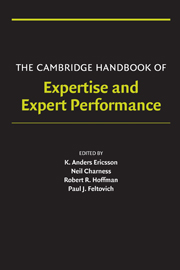Book contents
- Frontmatter
- Contents
- Acknowledgments
- Contributors
- PART I INTRODUCTION AND PERSPECTIVE
- PART II OVERVIEW OF APPROACHES TO THE STUDY OF EXPERTISE – BRIEF HISTORICAL ACCOUNTS OF THEORIES AND METHODS
- PART III METHODS FOR STUDYING THE STRUCTURE OF EXPERTISE
- PART IV METHODS FOR STUDYING THE ACQUISITION AND MAINTENANCE OF EXPERTISE
- PART V DOMAINS OF EXPERTISE
- PART V.A PROFESSIONAL DOMAINS
- 19 Expertise in Medicine and Surgery
- 20 Expertise and Transportation
- 21 Expertise in Software Design
- 22 Professional Writing Expertise
- 23 Professional Judgments and “Naturalistic Decision Making”
- 24 Decision-Making Expertise
- 25 The Making of a Dream Team: When Expert Teams Do Best
- PART V.B ARTS, SPORTS, & MOTOR SKILLS
- PART V.C GAMES AND OTHER TYPES OF EXPERTISE
- PART VI GENERALIZABLE MECHANISMS MEDIATING EXPERTISE AND GENERAL ISSUES
- Author Index
- Subject Index
- References
23 - Professional Judgments and “Naturalistic Decision Making”
from PART V.A - PROFESSIONAL DOMAINS
- Frontmatter
- Contents
- Acknowledgments
- Contributors
- PART I INTRODUCTION AND PERSPECTIVE
- PART II OVERVIEW OF APPROACHES TO THE STUDY OF EXPERTISE – BRIEF HISTORICAL ACCOUNTS OF THEORIES AND METHODS
- PART III METHODS FOR STUDYING THE STRUCTURE OF EXPERTISE
- PART IV METHODS FOR STUDYING THE ACQUISITION AND MAINTENANCE OF EXPERTISE
- PART V DOMAINS OF EXPERTISE
- PART V.A PROFESSIONAL DOMAINS
- 19 Expertise in Medicine and Surgery
- 20 Expertise and Transportation
- 21 Expertise in Software Design
- 22 Professional Writing Expertise
- 23 Professional Judgments and “Naturalistic Decision Making”
- 24 Decision-Making Expertise
- 25 The Making of a Dream Team: When Expert Teams Do Best
- PART V.B ARTS, SPORTS, & MOTOR SKILLS
- PART V.C GAMES AND OTHER TYPES OF EXPERTISE
- PART VI GENERALIZABLE MECHANISMS MEDIATING EXPERTISE AND GENERAL ISSUES
- Author Index
- Subject Index
- References
Summary
This chapter looks at expertise from the perspective of the community of practice known as Naturalistic Decision Making (NDM). We provide an overview of the emergence of NDM, the underlying theoretical orientation, and key NDM research. We discuss the impact NDM has had on one particular domain of expert judgment, military decision making. We conclude by discussing applications and continuing research issues in NDM.
Emergence of Naturalistic Decision Making
The focus of NDM research is on expert practitioners trying to figure out what to do under difficult circumstances. The need to understand decision making in the context of time pressure, uncertainty, ill-defined goals, and high personal stakes was a major impetus for the emergence of NDM. The coalescence of NDM as a field of study was marked by the publication of Decision Making in Action: Models and Methods (G. A. Klein, Orasanu, Calderwood, & Zsambok, 1993).
Zsambok (1997) described how this publication brought together the contextual factors that defined NDM:
The identification of key contextual factors that affect the way real-world decision making occurs, in contrast to their counterparts in the traditional decision research paradigm, evolved as a major contribution of the 1989 NDM conference (Orasanu & Connolly, 1993). They are: 1. Ill-structured problems (not artificial, well-structured problems). 2. Uncertain, dynamic environments (not static, simulated situations). 3. Shifting, ill-defined, or competing goals (not clear and stable goals). 4. Action/feedback loops (not one-shot decisions). 5. Time stress (as opposed to ample time for tasks). 6. High stakes (not situations devoid of true consequences for the decision maker). […]
- Type
- Chapter
- Information
- The Cambridge Handbook of Expertise and Expert Performance , pp. 403 - 420Publisher: Cambridge University PressPrint publication year: 2006
References
- 51
- Cited by



